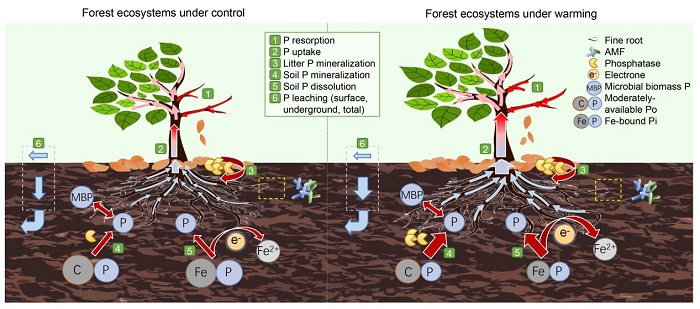

Phosphorus (P) is often one of the most limiting nutrients in highly weathered soils of humid tropical forests and may regulate the responses of carbon (C) feedback to climate warming. However, the response of P to warming at the ecosystem level in tropical forests is not well understood because previous studies have not comprehensively assessed changes in multiple P processes associated with warming.
To address the uncertainty related to P process, researchers from South China Botanical Garden of Chinese Academy of Sciences detected changes in the ecosystem P cycle in response to a 7-year continuous warming experiment by translocating model plant-soil ecosystems across a 600-m elevation gradient, equivalent to a temperature change of 2.1°C.
Results showed that warming increased P content and decreased foliar N:P. Increased plant P content was supplied by multiple processes, including enhancedplant P resorption, soil P mineralization, and dissolution, without changing litter P mineralization and leachate P. These findings suggest that warming increased plant-soil biological and soil geochemical controls of plant-soil P-cycle, by “pumping” P from soils to relatively fast-cycling plants.
Our study provides new insights into tropical P cycling and facilitates more accurate modelling of forest P limitation under warming. The findings extend the traditional assessment methodology (i.e., measurement of P supply by available/soluble P) and current paradigm (assessing P conversion only by soil P mineralization). This suggests that previous studies may have overestimated the negative impacts of P limitation on ecosystem C stock, under at least short-term or medium-term future warming.
This work has been published online in Global Change Biology, entitled "Warming drives sustained plant phosphorus demand in a humid tropical forests". Dr. Zhiyang Lie is first author of the paper, and Prof. Juxiu Liu is corresponding author. For further reading, please refer to:https://doi.org/10.1111/gcb.16194. This is the third article published in Global Change Biology based on warming platform in the Dinghushan Station, the other two articles can be found athttps://doi.org/10.1111/gcb.15432 , and https://doi.org/10.1111/gcb.15355 .

Figure. Schematic diagram illustrating the consequences of warming on P cycle

